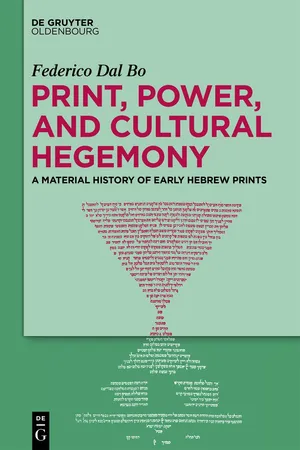
Print, Power, and Cultural Hegemony
A Material History of Early Hebrew Prints
- 367 pages
- English
- ePUB (mobile friendly)
- Available on iOS & Android
About this book
Federico Dal Bo examines the design of early Hebrew books from the late fifteenth and sixteenth centuries, focusing not only on the words in these early books but also on how they were arranged on the page. He follows in the tradition of scholars such as Christopher de Hamel, Marvin J. Heller, and David Stern, who have explored the importance of these Hebrew books in influencing Jewish learning and attracting the interest of Christians.
The author discusses important prints, such as the first Talmud and rabbinical bibles, which marked a shift from being for Jewish readers only to being for both Jews and Christians. The collaboration between Jewish editors and Christian printers changed the way these books looked and the audience for whom they were intended. At first, these early prints copied the style of handwritten Hebrew manuscripts. The simple layout could be difficult to read, especially for long books like the Bible or Talmud. But over time, influenced by the humanism of the Italian Renaissance, the layout became more complex. The book also looks at how the layout changed from full-page commentaries to a more complicated design in which the main text and commentaries shared the same page. This shift challenged the idea of who was the primary author and emphasized the role of editors. The layout, with the main text in the center and the commentaries on the sides, created a kind of unwritten rule for how to read religious texts. Dal Bo's study also includes new information about a 1553 trial in which the Talmud was burned. Overall, it explores how the layout of these early Hebrew books shaped cultural power and influenced how people read.
Frequently asked questions
- Essential is ideal for learners and professionals who enjoy exploring a wide range of subjects. Access the Essential Library with 800,000+ trusted titles and best-sellers across business, personal growth, and the humanities. Includes unlimited reading time and Standard Read Aloud voice.
- Complete: Perfect for advanced learners and researchers needing full, unrestricted access. Unlock 1.4M+ books across hundreds of subjects, including academic and specialized titles. The Complete Plan also includes advanced features like Premium Read Aloud and Research Assistant.
Please note we cannot support devices running on iOS 13 and Android 7 or earlier. Learn more about using the app.
Information
Table of contents
- Title Page
- Copyright
- Contents
- Introduction. A Micro-Historical Perspective on Early Hebrew Prints
- 1 Errancy of Print. Early Hebrew Prints from Sefarad to Italy
- 2 Establishing Hegemony. Daniel Bomberg’s First Rabbinic Bible
- 3 Centrality of Print. Daniel Bomberg’s Second Rabbinic Bible
- 4 Back to Origins. The Burning of the Talmud and its Discontents
- 5 The Return of the Repressed. Printing the Zohar as a Biblical Commentary
- Conclusion. Early Hebrew Prints Today
- Index